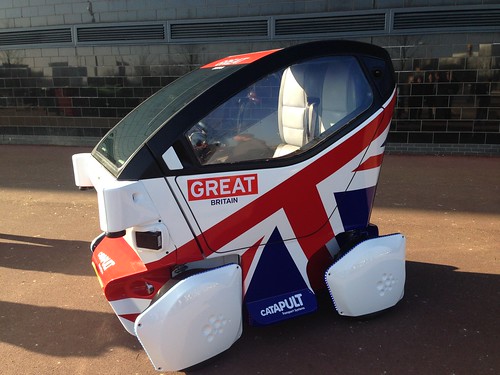第一台專為英國道路設計的自動駕駛電動車,上月在格林威治一場官方活動中正式亮相。英國政府預計,將在今春啟動道路測試。
自動駕駛車輛 交通路網轉型
這台自動駕駛汽車 LUTZ Pathfinder pod,是兩人座的電動車,還有放置行李的空間。最高車速約每小時24公里,續航時間約8小時或航程64公里。
車上配有19個感應器,還有相機、雷達和光學雷達。使用者可以用智慧型手機的app來招呼這台車。
英國商務大臣Vince Cable和交通部長Claire Perry都出席了上月的展示會。
交通部長Perry說他希望英國能領先全球。「自動駕駛汽車將是未來的趨勢,我希望英國可以成為這個新技術的領頭羊,這個技術可以使整個交通網路轉型,並為全球投資者開啟一條嶄新的大道。」
商務大臣Cable則說:「英國擁有最頂尖的自動駕駛技術,從所有在Sunderland製造的電動車到專業的一級方程式Midland賽車車隊都可證實這一點。我們一直不斷的創新,這對工作、發展和整個社會而言都十分重要。這也是為什麼我會舉辦關於研發自動駕駛汽車的競賽。」
Cable補充:「這個計劃目前在Greenwich、Bristol、Milton Keynes和Coventry4座城市進行,以確保我們在這個領域領先全世界。預計在2025年,這個產業的產值將上看9千億英鎊(約44兆台幣),希望我們可以在這個產業捷足先登。」
搶利基市場 英盼當低碳運輸領頭羊
LUTZ Pathfinder pod(LUTZ為「低碳都市運輸區域」縮寫)是屬於英國政府「自動駕駛計劃」中的一部分,由英國國家創新局(Innovate UK)下的機構Transport Systems Catapult所主導,總共投入約2000萬英鎊(約9.8億台幣)的資金。
LUTZ Pathfinder pod 的技術,則是由英國汽車委員會(UK Automotive Council)的商業、創新暨技能部、工程公司RDM Group和牛津大學Mobile Robotics Group所共同開發;而總部設在科芬特里的工程公司RDM Group,則是負責在造價40萬英鎊(約1900萬台幣)的高級工程中心裡製造這台車。
這一系列車款將配有牛津大學Mobile Robotics Group開發的感應器和導航技術。其中3台車將會先在Milton Keynes城裡測試,確保它們能一如預期的執行行駛高速公路的程式。如果測試成功,下一波測試行動將會由40台車所組成的車隊來進行。
RDM的董事長David Keene解釋:「這個由Transport Systems Catapult資助的「低碳都市運輸計劃」,是最新一連串針對車輛利基市場的計劃,可能使我們開創一番新的事業。」
智慧型行動 英國砸錢研發
Transport Systems Catapult是英國「智慧型行動」(intelligent mobility)的科技和研發中心,在去年12月對自動駕駛技術的投資中扮演了舉足輕重的角色。在其他測試的計劃中也累積了約4000萬英鎊(約19.5億台幣)的資金,主要是由英國政府和私人企業聯合資助。
去年7月,因為Innovate UK舉辦了「在英國的道路上引進自動駕駛汽車」(Introducing driverless cars to UK roads)這個競賽,使自動駕駛汽車的技術往前邁進了一大步。
這個競賽原本預計可以獲得1000萬英鎊(約4.9億台幣)的資金挹注,但在12月的秋季預算報告中,英國財政大臣George Osborne宣布政府將加碼900萬英鎊(約4.4億台幣)的資金,達到1900萬英鎊(約9.3億台幣)。
與其他3個共同參與計劃的私人集團投資結合,英國現在已經投入約4000萬英鎊(約19.5億台幣)的資金在開發這個新領域的技術。
Transport Systems Catapult執行長Steve Yianni在12月的聲明說:「Transport Systems Catapult致力於『智慧型行動』的發展,並使新技術有足夠的發展資金,確保英國在這些新科技領域中領先群雄。」
下一步:道路測試、訂新法規
在設計、工程顧問公司Arup的帶領下,英國自動駕駛計劃的下一步,即將要來看大眾在Milton Keynes和Coventry城裡,面對這些自動駕駛汽車會有什麼反應。由這些實際上路的測試,來研擬新的法規和保險,讓這些自動駕駛汽車更安全、計劃更可行。
Yianni補充,Catapult會持續支持並提供相關知識給其他兩個集團,另外兩個集團將進行Greenwich和Bristol兩座城市的測試計劃。
這個研究將提供汽車製造廠、城市、商業營運者、立法者和保險公司一些蛛絲馬跡,以便於制定配合自動駕駛技術的新法律與規範。
UK Autodrive計劃執行長Tim Armitage說:「實際的道路測試的計劃已經開始進行,目前是一台自動駕駛汽車行駛在封閉的道路上,慢慢進步到所有的道路使用者、立法者、警察和保險公司都對自動駕駛汽車有信心,直到全自動和半自動駕駛汽車可以安全的行駛在英國的路上。」
The first autonomous vehicle designed to run on UK public roads was officially unveiled at a government launch event in Greenwich earlier this month. Road tests are set to begin this spring.
The LUTZ, for Low-carbon Urban Transport Zone, Pathfinder pod is part of the UK Government’s Transport Systems Catapult Autodrive project, a £20 million (US$30.8 million) project.
The LUTZ Pathfinder pod is a two-seat electric car with space for luggage. It has a top speed of 15 mph (24 km/h) and a range of 40 miles (64 km) or can run for eight hours.
The self-driving equipment includes 19 sensors, cameras, radar and Lidar. Users can hail them by using a smartphone app.
A prototype of the LUTZ Pathfinder pod was presented to the media at the February 11 event, which was attended by Business Secretary Vince Cable and Transport Minister Claire Perry.
Transport Minister Perry said she wants the UK to take the lead internationally. “Driverless cars are the future. I want Britain to be at the forefront of this exciting new development, to embrace a technology that could transform our roads and open up a brand new route for global investment.”
Business Secretary Cable said, “The UK is at the cutting edge of automotive technology – from the all-electric cars built in Sunderland, to the Formula 1 expertise in the Midlands. It’s important for jobs, growth and society that we keep at the forefront of innovation – that’s why I launched a competition to research and develop driverless cars.”
“The projects we are now funding in Greenwich, Bristol, Milton Keynes and Coventry will help to ensure we are world-leaders in this field and able to benefit from what is expected to be a £900 billion industry by 2025,” said Cable.
The LUTZ Pathfinder pod is being developed by the UK Automotive Council, Department for Business, Innovation and Skills, RDM Group and the University of Oxford Mobile Robotics Group.
The LUTZ pods are being built by the Coventry-based advanced engineering company RDM Group. RDM will manufacture the pods at its new £400,000 advanced engineering centre in Coventry.
They will be equipped with sensor and navigation technology provided by the University of Oxford’s Mobile Robotics Group.
Three of the LUTZ Pathfinder pods will be tested in the town of Milton Keynes later this year to ensure that they can comply with the Highway Code. If the tests are successful, a fleet of 40 pods will be rolled out for further testing.
David Keene, chairman of RDM, explained, “The Low Carbon Urban Transit program, which is funded by the Transport Systems Catapult, is the latest in a long line of niche vehicle builds and could open the door for a whole host of new opportunities for us as a business.”
The Transport Systems Catapult, the UK’s technology and innovation center for “intelligent mobility,” played a major part in securing the investment in driverless technology in December 2014, culminating in a £40 million testing program jointly funded by the UK government and private industry.
This push toward autonomous cars began when the “Introducing driverless cars to UK roads” competition was launched in July by the UK’s innovation agency, Innovate UK.
The Innovate UK competition was originally due to receive a total of £10 million in funding. But in December’s Autumn Statement, Chancellor of the Exchequer George Osborne announced that the government was injecting an additional £9 million into the competition.
Combined with the private investments being made by the project partners in the three successful consortia, the UK is now set to invest around £40 million in developing this new field of technology.
“The Transport Systems Catapult was created to champion intelligent mobility and to drive major investment in new technologies that can position the UK as global leaders in this field,” Transport Systems Catapult CEO Steve Yianni said, following the December announcement.
Led by design and engineering consultants Arup, the UK Autodrive program will see research teams test public reaction to autonomous vehicles around Milton Keynes and Coventry, carry out real-world testing on public roads and footpaths, and develop new legal and insurance protocols to make driverless mobility safe and viable.
Yianni added that the Catapult would also be keen to provide support and know-how to the other two consortia, who will be trialling vehicles in Greenwich and Bristol.
UK Autodrive will deliver a program of feasibility studies and practical demonstrations in Milton Keynes and Coventry, where the city councils are taking the lead in developing the urban infrastructure technologies required to support driverless mobility.
The feasibility studies will consider the challenges of introducing self-driving vehicles from a technical, social and economic perspective.
The studies will provide insights for vehicle manufacturers, cities, commercial operators, legislators and insurers to develop the legal framework for the roll-out of autonomous mobility.
Tim Armitage, UK Autodrive Project Director, Arup, said, “Our plan with the practical demonstration phases is to start testing with single vehicles on closed roads, and to build up to a point where all road users, as well as legislators, the police and insurance companies, are confident about how driverless pods and fully and partially autonomous cars can operate safely on UK roads.”
The partners in the UK Autodrive consortium are Arup, Milton Keynes Council, Coventry Council, Jaguar Land Rover, Ford Motor Company, Tata Motors European Technical Centre, RDM Group, MIRA, Thales (UK), Oxbotica, AXA, the international law firm Wragge Lawrence Graham & Co, the Transport Systems Catapult, the University of Oxford, University of Cambridge, and the Open University.
※ 全文及圖片詳見:ENS
※ 守護環境知情權,捐款支持環境資訊中心!※



